At work I make a 'Pain de campagne' style loaf that features a whole wheat preferment. The outcome is a delicious dough with a flubbery like feeling when it comes off the mixer. It is an all around good loaf of bread for toast, sandwichs, dipping and so on. I have come to enjoy the flavors offered by prefermenting whole grains which is why I decieded to formulate this new recipe featuring a whole grain preferment, but better yet, a whole-rye sour also removing any commercial yeast from the loaf!
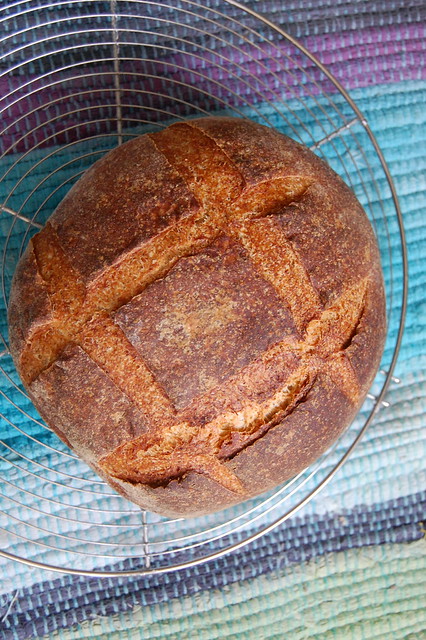
Now, I live in the heart of the capital of Michigan...hardly the country. So I felt it wasn't right in calling this loaf a 'country bread'. So I suppose it is my Pain de Urban if you will. The formula for the loaf follows;
Rye Sour -
The night before or depending on how active your rye starter is;
3.4 oz whole rye flour - 24.3%
3.4 oz water (68 degree water for me at the time, my apartment was very hot with the 90+ degree weather outside before I went to bed) - 24.3%
1 tspn of starter
Combine to form a paste lightly sprinkle the top with rye flour. Let ferment until the starter is ready for use. The flour on top should form little islands.
Dough -
All of rye starter
10.57 oz all purpose flour (used KAF) - 75.8%
.25 oz salt (used grey salt) 1.7%
5.1 oz water (once again I used a bit cooler water since even at 4 a.m. my apartment was rather hot) - 36.5%
Combine all the ingredients in your mixer, holding back a little bit of the water. Mix till a shaggy mass forms, at this point turn off the mixer, reach inside and squeeze the shaggy mass. If the center feels a bit dry, add the water and continue mixing for another thirty seconds or so. Turn off the mixer if needed and check again. A bit more water may be needed at this point, but if you take a look at the doughs percentages, this isn't really a 'rustic' loaf, its around 60% hydration. Complete the mix till it cleans the bowl and forms a very low degree of window pane.
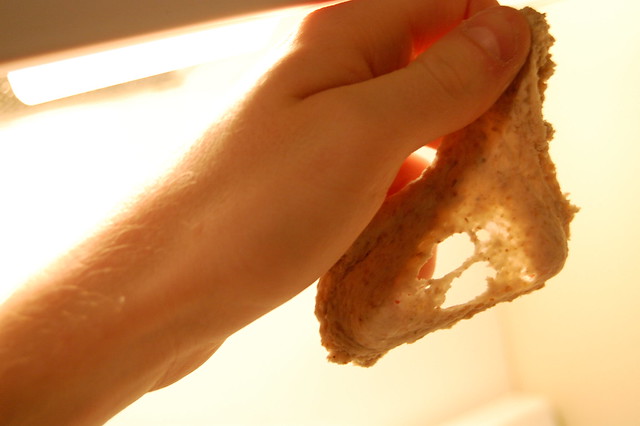
At this point though, the loaf should be fairly smooth, but not fully developed. The developing will come later with a stretch and fold on the bench.
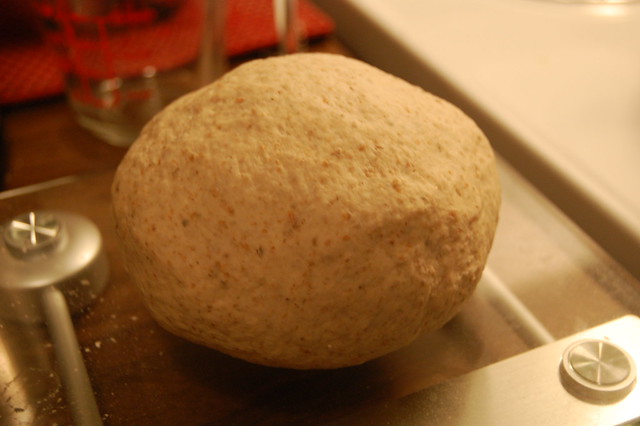
This was my dough after mixing, I'd say very presentable!
Allow the dough to ferment for one hour, apply a stretch and fold and return to your proofing bowl/basket/bucket/ect. After two and a half hours, my dough became nicely fermented and was ready for shaping!
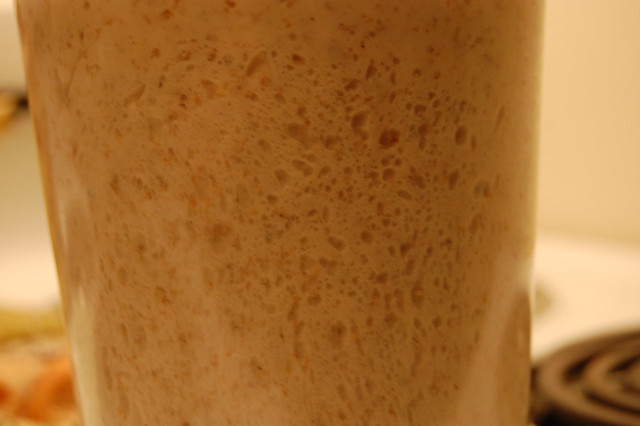
Numerous bubbles of all sizes all over the dough and easily doubled in size. The dough felt supple as I removed it gently from the container to begin with shaping.
I shaped the loaf into a boule and placed on linen and covered. An hour before you think the loaf is ready, pre-heat your oven to 450 and prepare whatever new wild steaming method you find to be helpful. For me today, since I was baking one loaf, I used the good old dutch oven.
The final proof lasted around two and a half hours. I then scored the loaf gently and placed under the dutch oven for twenty minutes covered. After twenty minutes, I uncovered the loaf and let it bake for another twenty minutes, then a final five minutes with the oven off.
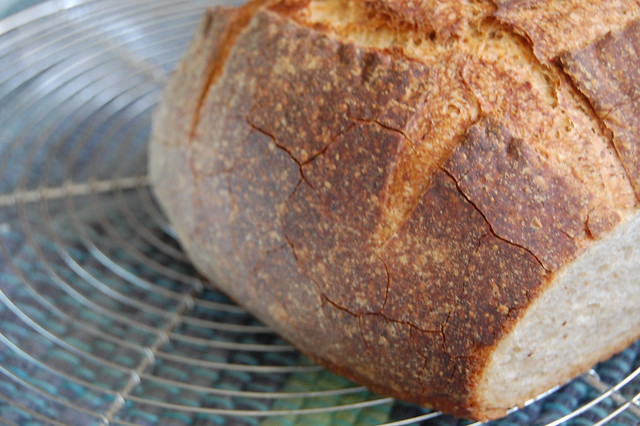
Crisp, crackley crust, and a nice rye flavor to it.
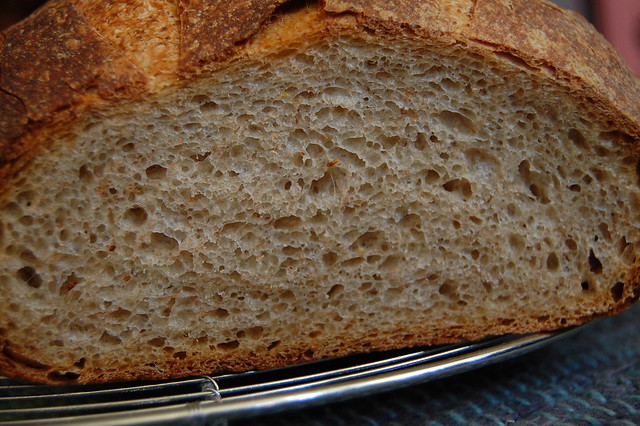
It went well as a vessle for Dubliner cheese grilled and pressed sandwiches served with a side of some fancy french mustard as my friend and I brewed some more beer this weekend. Our ritual is now becoming beer brewing, discussion of new tattoos, and delicious sandwichs when all is said and done. I am ok with that.
- arlo's Blog
- Log in or register to post comments
Very nice arlo! Looks delicious.
Good bread, good beer, and good friends. I am ok with that too. :)
Great bread Arlo.
Eric
Country? Urban? This is just fine looking bread Arlo no matter what name it goes by! I love this type of loaf for it's combination of grain flavours and sour. Excellent loaf on all counts.
Franko
Nice formula, great looking crust and crumb. I've used 50% whole grain pre-ferments (ala Tartine), but I'll have to try 100% some time.
Glenn
It looks wonderful!
David
That is a teriffic looking bread. Beautiful crumb. Perfectly risen and baked. I couldn't agree with you more: including the whole grains in the preferment adds a lot of flavour to the bread. Much more than if they are added at a later stage. Nice baking.
Syd
Lovely Urban Boule, Arlo! Perfect fermentation for this type of dough hydration..Crust looks beautiful too.. all is well for this loaf, Arlo.
Lovely loaf with great colour on the crust and beautiful crumb!
Been thinking of baking rye-sour based bread myself, too, to see if it works for my trial-imitation of Pain de Lodeve. Love to borrow your formula to use it as a guidance for my experiment, if you don't mind.
Thanks for sharing. :)
best wishes,
lumos
ETA : Love the naming of the loaf, too!
My hearts a flutter from all those nice comments. Thanks everyone.
@Glenn - Please do try 100% rye or whole wheat preferment, I think you'll be more pleased with the rye though. It really does add a lot of flavor to loaf. Plus with the way your loaves turn out so great, I am sure you could impress us with a nice loaf.
@Lumos - By all means, I post it so others can try my recipes :)
Boy that just looks great, the crust, the crumb, the works. I can imagine that the rye sour just yields such a nice flavor, and I think you've got a nice open crumb for a bread with a fairly low hydration.
Nice job...and good eating!
Larry
have to agree with everyone else - great-looking crust and crumb. Love that reddish crust especially. another must-try
Part of my vacation was having my niece show me her tattoos and explain her reasons for each one. I couldn't reciprocate being an old fuddy duddy. Beautiful bread. You got a great crumb and I hope to try your formula and see if I can get anywhere close. -Varda
Thanks for posting the semi-window-pane shot. I'm never quite sure how much to knead to get the "partial" gluten development needed to accommodate later S&F's. The stage in your photo looks very familiar and your crumb looks absolutely beautiful, so I think you've given me a new target to tinker with. Thanks Arlo.
Marcus
The tattoos, well I suppose I should post them, they are bread related and all :)
Hello arlo,
This is a late reply - but wanted to say I think this is a really good-looking loaf of bread! and it must have tasted wonderful being built up from your rye sour.
Love the picture too of the dough at the end of bulk ferment, in its clear container, showing all of those bubbles.
:^) from breadsong
I'd got an order from my friend to make my fau-=Poilane to deliver tomorrow, but after reading Syd's blog reporting the wonderful result of his take on this great bread, I decided I really needed to bake this myself.....so that, as Syd said, this might join my ever-increasing 'Bread to Bake' list (slightly shorter than The Great Wall of China, at the mo) and get buried there for a looong time. So I rang the frined and asked if she'd be interested in trying this instead of faux-Poilane, and luckily she said she was. (Good to have a friend as your customer :p)
So, this IS the bread I'm baking tomorrow!.....but a few questions I'd like to ask if I may.
Can you please clarify this part....?
Combine to form a paste lightly sprinkle the top with rye flour. Let ferment until the starter is ready for use. The flour on top should form little islands.
Do you sprinkle the top with extra rye flour? (other than the stated amont of rye in the ingredients?) And what 's the purpose of it? Is it as a sign to tell you when the sour is ready?
Also, because of the scheduling issues, I may have to cold-retard for several hours, either during bulk fermentation or proof. I know dough with rye doesn't like long fermentation, but total rye proportion is only about a 1/4 and all of it in the sour, rather than the main dough ingredients, I'm wondering if 6-10 hr retardation in the fridge is safe enough. Sorry, this is the first time I've ever used rye-sour based bread, if you could give me some guidance, it'd be really appreciated.
Thanks in advance.
lumos, with the brave friend :p
wow, didn't expect to get a reply so quickly! Thanks, arlo. Much appreciated....and sorry to bother you during your tea break.
Since never used rye sour before, your tip of using sprinkled extra rye as an indicator is really great. Thanks for that, too. I'm sur it'll stay with me for long time.
As for retardation, yeah, I read Syd did retard but it was only for 3 hrs, so I've been wondering if rye will endure much longer retard like 6-10 hrs. I've done long, cold retard with up to 10% rye dough, but nothing more, and have no experience in rye sour at all.
I may just change my baking timetable and start feeding the starter later, so that it'd be ready tomorrow morning rather than this evening, and start preparing the main dough tomorrow, to be on the safe side.
As I promised, I baked this bread yesterday. I adjusted your formula to make the hydration of rye sour 75% and lower the ratio of rye to around 20%. The reason being, because of scheduling issue I needed to cold retard for overnight, I thought it'd be safer to reduce the proportion of rye sour than your original formula.
Long story short, this is how it turned out.
Baked in a Pyrex, 20 minutes with a lid, another 20 minutes without with lower temperature, which is my usual procedure. I thought I might have had over-proofed a little, but the expansion in the oven was amazing, probably it wasn't too bad.
For some reason the crust gained more colour than usual......the reason I found later. The friend who ordered this bread kindly cut off a small piece for me to taste it, and I was really surprised it was so sweet. Not sugarly, sticky sweet, but naturally sweet. I have baked light rye breads with the similar ratio of rye flour but with white wheat flour based starter, but this one's sweetness is much more distinct than those. Is it because of rye sour, do you think?
Anyway, the guinea pig friend seems to be happy, so now I've got to make one for ourselves. Watch this space....or my space, maybe. :p
Thank you very much, again, for sharing this, Arlo!
Walnut bread (right), made with the same dough.
lumos
Those look excellent Lumos! My guess is that all that sugar and hence the colour is because of the inclusion of the rye in the preferment. The crust on this loaf was one of my all time favourites. It just had so much flavour. Great baking.
Syd
Thanks, Syd. :)
The differences, presumably, rye sour made were quite interesting. My formula was quite a bit 'mutilated' from Arlo's original (Sorry, Arlo!!!), so the experience I had might well be just unique to me, but I found the rye flavour was not as apparent as the dough with a similar ratio of rye but made with wheat flour starter. And instead of slight acidity which is typical of rye, the sweetness was the first thing I tasted. It did have a tang, but it was more, sort of, muted. Did you find the same with your loaf, too?
Been wondering if some sort of saccharisation (right word?) happens to rye flour while pre-fermenting......?????
lumos
Nicely done Lumos, glad you enjoyed it. As far as the flavors you are experiencing goes. Everyone has a different set of taste buds, so it may be true for you :) But having lowered the amount of rye and hydration of the starter may have caused the lessening of the tang compared to what my original loaf had.
Either way, I liked the inclusion of walnuts.
Thanks, Arlo....and sorry for mutilating your original formula. :p
I was comparing the flavour to my own regular light rye with a similar rye ration and hydration, so the difference was really intriguing. I'll certainly make another one with much closer formula to your original soon. ;)
Thanks for sharing your great recipe. It was especially good because it finally forced me into using rye sour for the first time ever! :p
lumos
I just discovered this while puttering around on the site and I'm so glad I did. What a wonderful looking bread! I have to try it. Lumos's version looks outstanding, too. I love your name for it too!
Janie